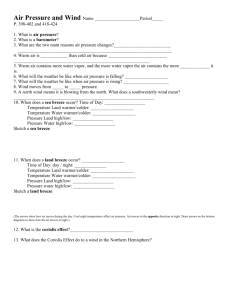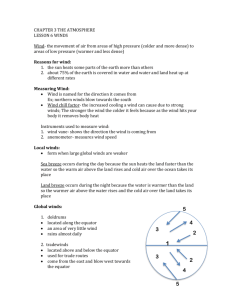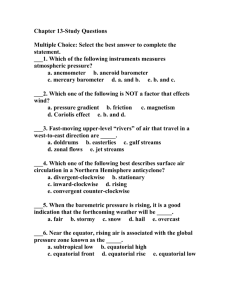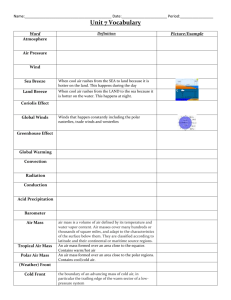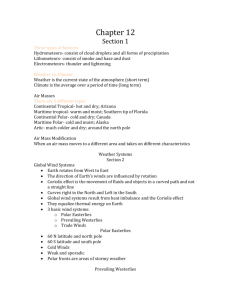GLOBAL WINDS
advertisement
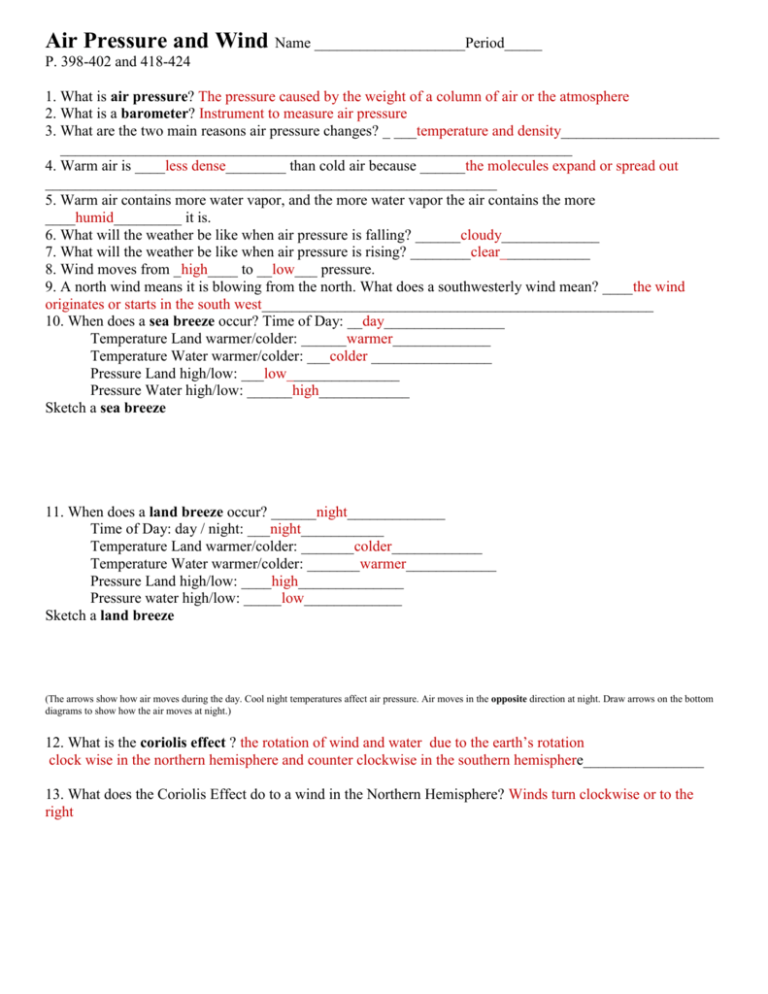
Air Pressure and Wind Name ____________________Period_____ P. 398-402 and 418-424 1. What is air pressure? The pressure caused by the weight of a column of air or the atmosphere 2. What is a barometer? Instrument to measure air pressure 3. What are the two main reasons air pressure changes? _ ___temperature and density_____________________ ____________________________________________________________________ 4. Warm air is ____less dense________ than cold air because ______the molecules expand or spread out ____________________________________________________________ 5. Warm air contains more water vapor, and the more water vapor the air contains the more ____humid_________ it is. 6. What will the weather be like when air pressure is falling? ______cloudy_____________ 7. What will the weather be like when air pressure is rising? ________clear____________ 8. Wind moves from _high____ to __low___ pressure. 9. A north wind means it is blowing from the north. What does a southwesterly wind mean? ____the wind originates or starts in the south west____________________________________________________ 10. When does a sea breeze occur? Time of Day: __day________________ Temperature Land warmer/colder: ______warmer_____________ Temperature Water warmer/colder: ___colder ________________ Pressure Land high/low: ___low_______________ Pressure Water high/low: ______high____________ Sketch a sea breeze 11. When does a land breeze occur? ______night_____________ Time of Day: day / night: ___night___________ Temperature Land warmer/colder: _______colder____________ Temperature Water warmer/colder: _______warmer____________ Pressure Land high/low: ____high______________ Pressure water high/low: _____low_____________ Sketch a land breeze (The arrows show how air moves during the day. Cool night temperatures affect air pressure. Air moves in the opposite direction at night. Draw arrows on the bottom diagrams to show how the air moves at night.) 12. What is the coriolis effect ? the rotation of wind and water due to the earth’s rotation clock wise in the northern hemisphere and counter clockwise in the southern hemisphere________________ 13. What does the Coriolis Effect do to a wind in the Northern Hemisphere? Winds turn clockwise or to the right GLOBAL WINDS Name _______________________ Period____________ DIRECTIONS: 1) Label the names of the global winds on the map below. 2) Finish drawing the direction of winds that are missing on the map. 3) Provide three facts about each of the wind patterns below. POLAR EASTERLIES: Located about 60° north and south of the Prevailing Westerlies. They bring cold air toward the lower latitudes. Start in the East and move west. PREVAILING WESTERLIES: Important to the weather of the United States, between 30° and 60° latitude, they blow from the west to the east TRADE WINDS: sailors use the trade winds to travel from Europe. 30 degrees north of the equator the winds go east to west and 30 south of the equator go west to east. DOLDRUMS: little to no wind, located near the equator, cool air moves into the area but it warms rapidly. Answer the following questions. 1. What causes the wind patterns to turn to the right in the northern hemisphere and to the left in the southern hemisphere? _____Coriolis Effect__________________________________ 2. In which direction do the polar easterlies move? ____From East to West_________________ 3. What winds did sailors rely on to move their cargos from Europe to the West Indies and South America? ___Trade Winds_______________ 4. Which winds play an important part in the weather here in the U.S.? ___Prevailing Westerlies_________________ 5. Name the winds near the equator with little or no wind? _____ Doldrums __________ Polar Easterlies Prevailing Westerlies Trade Winds Doldrums Trade Winds Prevailing Westerlies Polar Easterlies
